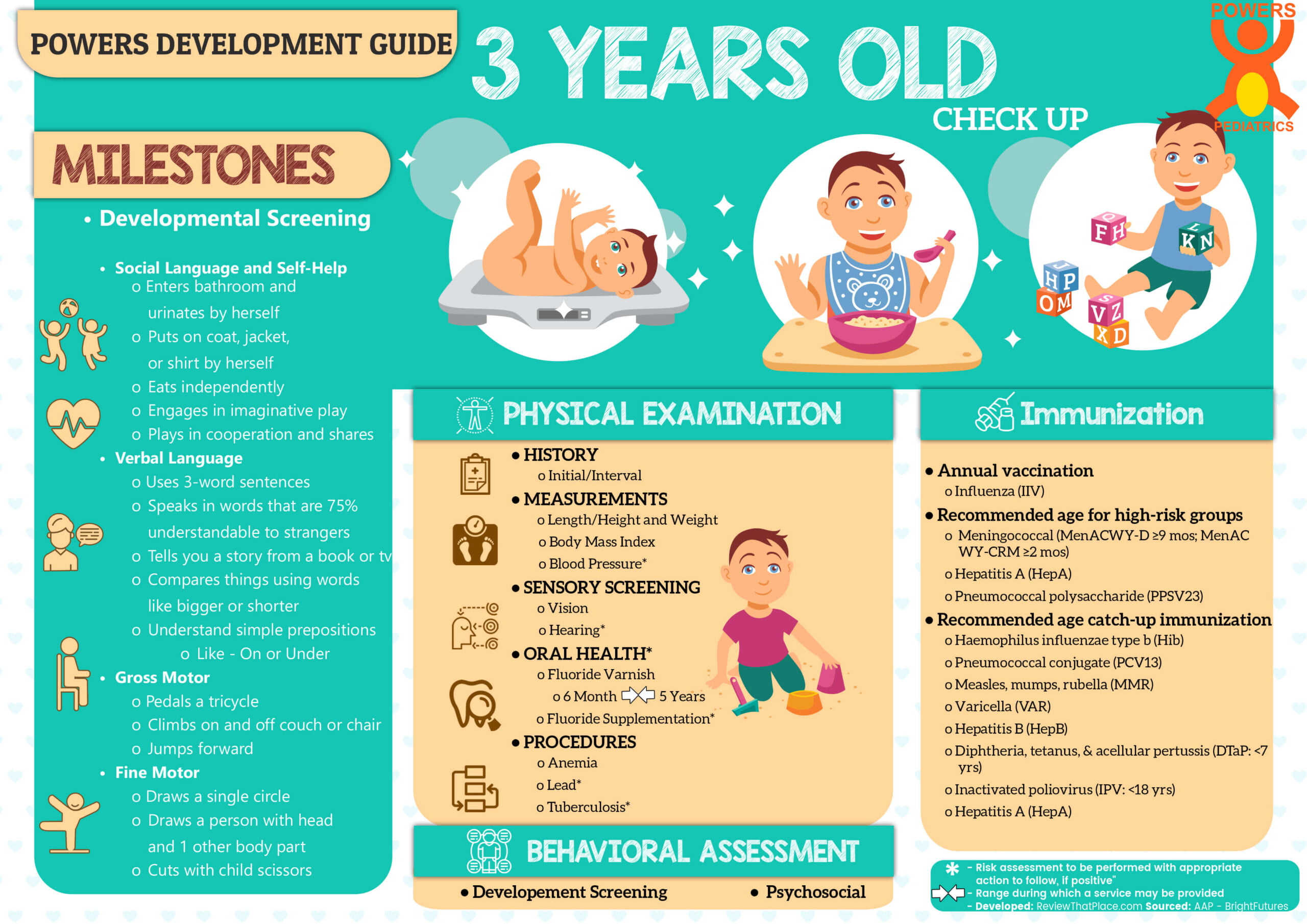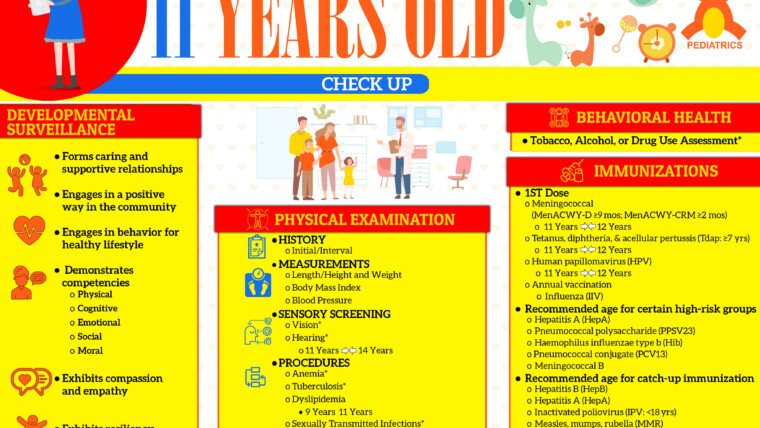What to except during a 3 Year Old Physical
1 DEVELOPMENTAL SCREENING
- Social Language and Self-Help
- Enters bathroom and urinates by herself
- Puts on coat, jacket, or shirt by herself
- Eats independently
- Engages in imaginative play
- Plays in cooperation and shares
- Verbal Language
- Uses 3-word sentences
- Speaks in words that are 75% understandable to strangers
- Tells you a story from a book or tv
- Compares things using words like bigger or shorter
- Understand simple prepositions
- Like – On or Under
- Gross Motor
- Pedals a tricycle
- Climbs on and off couch or chair
- Jumps forward
- Fine Motor
- Draws a single circle
- Draws a person with head and 1 other body part
- Cuts with child scissors
BEHAVIORAL HEALTH
4 PHYSICAL EXAMINATION
15 Immunization
- Recommended age for certain high-risk groups
- Meningococcal (MenACWY-D ≥9 mos; MenACWY-CRM ≥2 mos)
- Hepatitis A (HepA)
- Pneumococcal polysaccharide (PPSV23)
- Recommended age for catch-up immunization
- Haemophilus influenzae type b (Hib)
- Pneumococcal conjugate (PCV13)
- Measles, mumps, rubella (MMR)
- Varicella (VAR)
- Hepatitis B (HepB)
- Diphtheria, tetanus, & acellular pertussis (DTaP: <7 yrs)
- Inactivated poliovirus (IPV: <18 yrs)
- Hepatitis A (HepA)
- Influenza (IIV)
- Annual vaccination 1 or 2 doses
3 Years Old Anticipatory Guidance
Social determinants of health
◊ Risks (living situation and food security; tobacco, alcohol, and drugs)
◊ Strengths and Protective Factors (positive family interactions, work-life balance)
- Tell me about your living situation. Do you have the things you need to care for your child?
- Community agencies can help you with concerns about your living situation.
- Within the past 12 months, were you ever worried whether your food would run out before you got money to buy more? Within the past 12 months, did the food you bought not last and you did not have money to get more?
- Programs like WIC and SNAP are available to help you if you have concerns about your food situation.
- Don’t use tobacco/e-cigarettes/alcohol/drugs. Call 800-QUIT-NOW (800-784-8669) for help to quit smoking.
- Who loves you? How do you know?
- Show affection in family; handle anger constructively; give child opportunities to make choices.
- Take time for self, partner; create opportunities for family to spend time with the child.
Playing with siblings and peers
◊ Play Opportunities and Interactive Games ◊ Sibling Relationships
- Tell me about your child’s typical play.
- Encourage play with appropriate toys and safe exploration; expect fantasy play.
- Encourage interactive games with peers; explain importance of taking turns.
- Help your children develop good relations with each other.
Encouraging literacy activities
◊ Reading ◊ Talking ◊ Singing Together ◊ Language Development
- Read, sing, play rhyme games together; let child “tell” story; practice reading wherever you go.
- How does your child tell you what he wants? How well does the family understand his speech?
- Encourage child to talk about friends, experiences.
Promoting healthy nutrition and physical activity
◊ Water ◊ Milk ◊ Juice ◊ Nutritious Foods ◊ Competence in Motor Skills ◊ Limits on Inactivity
- Always have cool water available.
- Provide 16 to 24 oz low- fat/fat-free milk daily.
- Juice is not a necessary drink. If you choose to give juice, limit to 4 oz daily and always serve it with a meal.
- Offer variety of healthy foods /snacks, especially vegetables, fruits, lean protein.
- Trust child to decide how much to eat.
- Encourage opportunities for physical activity for child, family.
- Limit TV and other digital media to no more than 1 hour a day; monitor what child watches; consider making a family media use plan (www.healthychildren.org/MediaUsePlan).
Safety
◊ Car Safety Seats ◊ Choking Prevention ◊ Pedestrian Safety ◊ Falls from Windows ◊ Water Safety ◊ Pets ◊ Firearm safety
- Continue to use properly installed, size appropriate rear-facing or forward-facing car safety seat with 5-point harness. Keep car safety seat in the backseat.
- Prevent choking by cutting food into small pieces.
- Supervise all play near streets/driveways; don’t allow child to cross street alone.
- Move furniture away from windows; install operable window guards.
- Provide “touch supervision” near water, bathtubs, pools, toilet.
- Teach child about safety around pets.
- Remove firearms from home; if firearm necessary, store unloaded and locked, with ammunition locked separately; ask if firearms in other homes where child plays; if so, ensure same safety precautions are used before letting child play there.
Goals For 3 Year Check up:
- Be gentle and patient
- Get more sleep
- Make a budget
- Leave your work at the office
- Focus on self-care
- Meditate as a family
- Find an outlet
- “cell-free” zone
- Spend more time with your partner
- Take more baths
- Have a girls’/boys’ night
- Be more flexible
- See your child for who they are
- Teach your child to speak up
- Help those less fortunate
- Drink more water
- Find 30 minutes a day of “me” time
- Challenge yourself
- Focus on experiences, not things
- Make health a priority
- Start—or finish—a degree
- Inform yourself
- Maintain balance
- Laugh often
- Cook dinner more frequently
- Ask for help
- Have designated “cheat” days
- Stop having FOMO
- Say “I love you” more often
- A visual acuity screen is recommended at ages 4 and 5 years, as well as in cooperative 3-year-olds. Instrument-based screening may be used to assess risk at ages 12 and 24 months, in addition to the well visits at 3 through 5 years of age. (Reference) ↩︎
- This assessment should be family centered and may include an assessment of child social-emotional health, caregiver depression, and social determinants of health. (Reference) ↩︎
- At each visit, age-appropriate physical examination is essential, with infant totally unclothed and older children undressed and suitably draped. The extent of the physical examination is determined by both the reason for the visit and diagnostic considerations raised during the taking of the history. (Reference) ↩︎
- These may be modified, depending on entry point into schedule and individual need. ↩︎
- Screen, per reference. ↩︎
- Blood pressure measurement in infants and children with specific risk conditions should be performed at visits before age 3 years. (Reference) ↩︎
- A visual acuity screen is recommended at ages 4 and 5 years, as well as in cooperative 3-year-olds. Instrument-based screening may be used to assess risk at ages 12 and 24 months, in addition to the well visits at 3 through 5 years of age. (Reference) ↩︎
- Recommend brushing with fluoride toothpaste in the proper dosage for age. (Reference) ↩︎
- Once teeth are present, fluoride varnish may be applied to all children every 3–6 months in the primary care or dental office. (Reference) ↩︎
- If primary water source is deficient in fluoride, consider oral fluoride supplementation. (Reference) ↩︎
- These may be modified, depending on entry point into schedule and individual need. ↩︎
- Perform risk assessment or screening, as appropriate, per recommendations in the current edition of the AAP Pediatric Nutrition. ↩︎
- For children at risk of lead exposure, see reference. ↩︎
- Testing should be performed on recognition of high-risk factors. Tuberculosis testing per recommendations of the AAP Committee on Infectious Diseases. ↩︎
- Every visit should be an opportunity to update and complete a child’s immunizations. (Reference) ↩︎



